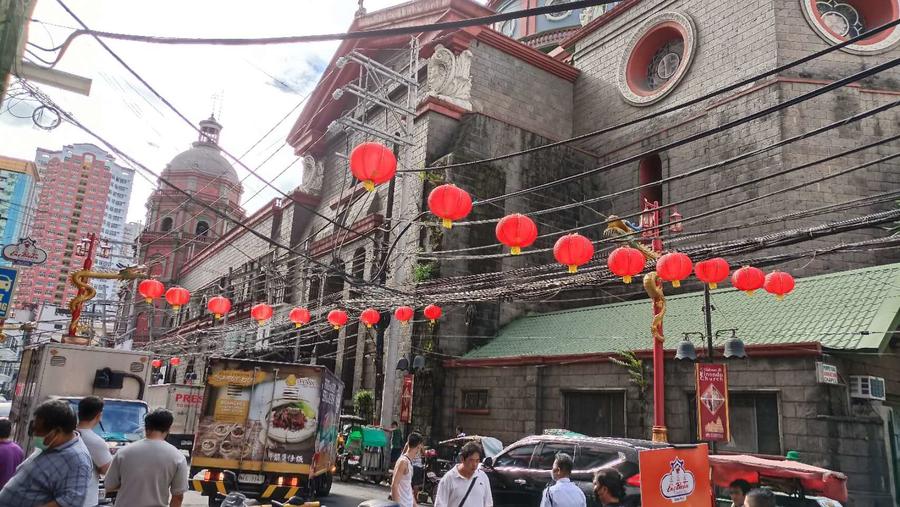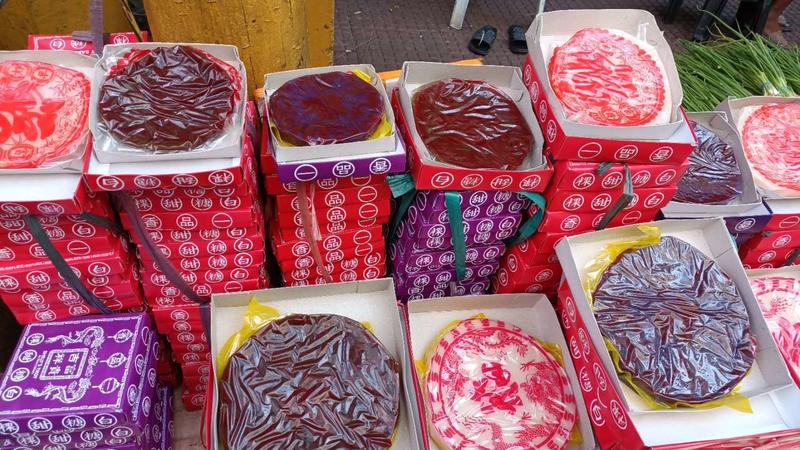 Celebrations for Lunar New Year of the Rabbit return with a bang in Manila’s Chinatown on Jan 18. (PHOTOS BY PRIME SARMIENTO / CHINA DAILY)
Celebrations for Lunar New Year of the Rabbit return with a bang in Manila’s Chinatown on Jan 18. (PHOTOS BY PRIME SARMIENTO / CHINA DAILY)
After nearly three years of subdued celebrations due to the COVID-19 pandemic, the Chinese-Filipino community is looking forward to a more exuberant observance of this year’s Spring Festival.
In Manila’s Binondo district, known as the city’s Chinatown, the local community is busy decorating its streets with red lanterns, while stores are offering boxes of nian gao (known by most Filipinos as ‘tikoy’) as this sweet rice cake is usually served in parties and given as gifts.
The Philippines will join most of Asia in celebrating a more festive, joyous Chinese New Year. This is the happiest in three years
Wilson Lee Flores, honorary chairman of the Anvil Business Club, an association of Chinese-Filipino entrepreneurs, is expecting a “more vibrant, more festive” Chinese New Year celebrations this year thanks to the easing of restrictions. In lieu of small family parties that were held at the height of the pandemic, Flores sees more gatherings and huge events this weekend to welcome the Year of the Water Rabbit.
READ MORE: Philippines wishes to boost ties with China in new year
“The Philippines will join most of Asia in celebrating a more festive, joyous Chinese New Year. This is the happiest in three years,” Flores said.
Such optimism also comes at a time when the Philippines and China have strengthened their bilateral ties, following the state visit of Philippine President Ferdinand Marcos Jr to Beijing earlier this month.
Marcos, who was in Switzerland this week to attend the World Economic Forum, has sent a video message to a celebration held by the Chinese embassy in the Philippines. After wishing for health and prosperity “for ourselves and our communities”, Marcos said the Chinese New Year celebration can serve as “an opportunity to look into our cultural and historical richness as a people and to strengthen the ties that bind us as a nation”.
 Spring Festival necessities are available on Chinatown markets of Manila. (PHOTOS BY PRIME SARMIENTO / CHINA DAILY)
Spring Festival necessities are available on Chinatown markets of Manila. (PHOTOS BY PRIME SARMIENTO / CHINA DAILY)
“May we all write a new vibrant chapter especially with our Filipino Chinese communities in securing good fortune, joy, and harmony,” he said.
Philippine Vice President Sara Duterte has likewise sent a video message, saying that she is looking forward to closer ties between the Philippines and China which is “grounded not only in our long and colorful history, but also based on mutual trust and mutual respect”.
Chinese Ambassador to the Philippines Huang Xilian said at the celebration, “Deepening friendly cooperation is what our people long for.”
Huang stressed the need to "gear up the important consensus" forged during Marcos' Beijing visit to new heights, with both sides further promoting cultural and people-to-people exchanges.
The annual Chinese New Year celebrations in Manila reflect the centuries-long ties between China and the Philippines. As early as the 10th century, Chinese merchants had been sailing to the Philippines, bringing ceramics and silk in exchange for pearls and hemp fabric.
Chinese-Philippine trading did not stop even during the Spanish colonial era, with some of the merchants choosing to stay and marry Filipino women. In the 16th century, the Spaniards designated a settlement for Chinese immigrants — this is now known as Binondo, a district in the capital city of Manila.
To this day, Binondo remains the center of Chinese-Filipino culture, home to restaurants that serve a fusion of Chinese and Filipino dishes, as well as Chinese schools, the country's biggest Chinese-Filipino business association, and a museum on Chinese-Filipino heritage.
While Binondo remains the main venue for festivities, the Lunar New Year celebrations in the Philippines extend beyond the Chinese-Filipino community, Lourdes Tanhueco Nepomuceno, director of the Confucius Institute-University of the Philippines in Diliman, pointed out.
“The Chinese culture in the Philippines impacts the lives of the majority of Filipinos,” Nepomuceno said. She noted that many Filipinos celebrate the Chinese New Year by dining in Chinese restaurants, consulting feng shui experts, reading their Chinese zodiac horoscope, and giving ang pao (red envelopes filled with cash) to family and friends.
READ MORE: China-Philippine cooperation 'far outweighs maritime spat in new Marcos era'
For the Chinese-Filipino community, the lifting of mobility and travel restrictions means people can finally “reunite with their loved ones after three years of restrictions and enforced separation”.
Nepomuceno, meanwhile, is also expecting an influx of Chinese tourists to the Philippines thanks to China's recent optimization of its COVID-19 response. China is one of the biggest markets for the Philippine travel and tourism industry.
Aaron Jed Rabena, research fellow at the Manila-based Asia Pacific Pathways to Progress, welcomes the return of Chinese tourists, noting that this will boost people to people exchanges and diplomatic ties.
“Personal touch really matters in diplomacy,” Rabena said.
Austin Ong, a research coordinator at the Integrated Development Studies Institute, a Manila-based think tank, said that by traveling to the Philippines, Chinese visitors can “feel and experience” what the Philippines has to offer, and strengthen people-to-people relationships.


